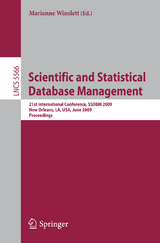Scientific and Statistical Database Management
Springer Berlin (Verlag)
978-3-642-02278-4 (ISBN)
Invited Presentation.- The Scientific Data Management Center: Providing Technologies for Large Scale Scientific Exploration.- Improving the End-User Experience.- Query Recommendations for Interactive Database Exploration.- Scientific Mashups: Runtime-Configurable Data Product Ensembles.- View Discovery in OLAP Databases through Statistical Combinatorial Optimization.- Designing a Geo-scientific Request Language - A Database Approach.- SEEDEEP: A System for Exploring and Querying Scientific Deep Web Data Sources.- Expressing OLAP Preferences.- Indexing, Physical Design, and Energy.- Energy Smart Management of Scientific Data.- Data Parallel Bin-Based Indexing for Answering Queries on Multi-core Architectures.- Finding Regions of Interest in Large Scientific Datasets.- Adaptive Physical Design for Curated Archives.- MLR-Index: An Index Structure for Fast and Scalable Similarity Search in High Dimensions.- Application Experience.- B-Fabric: An Open Source Life Sciences Data Management System.- Design and Implementation of Metadata System in PetaShare.- Covariant Evolutionary Event Analysis for Base Interaction Prediction Using a Relational Database Management System for RNA.- Invited Presentation.- What Makes Scientific Workflows Scientific?.- Workflow.- Enabling Ad Hoc Queries over Low-Level Scientific Data Sets.- Exploring Scientific Workflow Provenance Using Hybrid Queries over Nested Data and Lineage Graphs.- Data Integration with the DaltOn Framework - A Case Study.- Experiment Line: Software Reuse in Scientific Workflows.- Tracking Files in the Kepler Provenance Framework.- BioBrowsing: Making the Most of the Data Available in Entrez.- Using Workflow Medleys to Streamline Exploratory Tasks.- Query Processing.- Experiences on Processing Spatial Data with MapReduce.-Optimization and Execution of Complex Scientific Queries over Uncorrelated Experimental Data.- Comprehensive Optimization of Declarative Sensor Network Queries.- Efficient Evaluation of Generalized Tree-Pattern Queries with Same-Path Constraints.- Mode Aware Stream Query Processing.- Evaluating Reachability Queries over Path Collections.- Similarity Search.- Easing the Dimensionality Curse by Stretching Metric Spaces.- Probabilistic Similarity Search for Uncertain Time Series.- Reverse k-Nearest Neighbor Search Based on Aggregate Point Access Methods.- Finding Structural Similarity in Time Series Data Using Bag-of-Patterns Representation.- Keynote Address.- Cloud Computing for Science.- Mining.- Classification with Unknown Classes.- HSM: Heterogeneous Subspace Mining in High Dimensional Data.- Split-Order Distance for Clustering and Classification Hierarchies.- Combining Multiple Interrelated Streams for Incremental Clustering.- Improving Relation Extraction by Exploiting Properties of the Target Relation.- Cor-Split: Defending Privacy in Data Re-publication from Historical Correlations and Compromised Tuples.- A Bipartite Graph Framework for Summarizing High-Dimensional Binary, Categorical and Numeric Data.- Spatial Data.- Region Extraction and Verification for Spatial and Spatio-temporal Databases.- Identifying the Most Endangered Objects from Spatial Datasets.- Constraint-Based Learning of Distance Functions for Object Trajectories.
| Erscheint lt. Verlag | 22.5.2009 |
|---|---|
| Reihe/Serie | Information Systems and Applications, incl. Internet/Web, and HCI | Lecture Notes in Computer Science |
| Zusatzinfo | XIV, 648 p. |
| Verlagsort | Berlin |
| Sprache | englisch |
| Maße | 155 x 235 mm |
| Themenwelt | Informatik ► Theorie / Studium ► Algorithmen |
| Schlagworte | Architectures • Cloud Computing • constraint-based learning • Database • GIS • Hardcover, Softcover / Informatik, EDV/Informatik • high dimensional data • hybrid queries • nested date • OLAP • PetaShare • Relational Database • scientific databases • Spatial Data • VLDB |
| ISBN-10 | 3-642-02278-2 / 3642022782 |
| ISBN-13 | 978-3-642-02278-4 / 9783642022784 |
| Zustand | Neuware |
| Haben Sie eine Frage zum Produkt? |
aus dem Bereich




